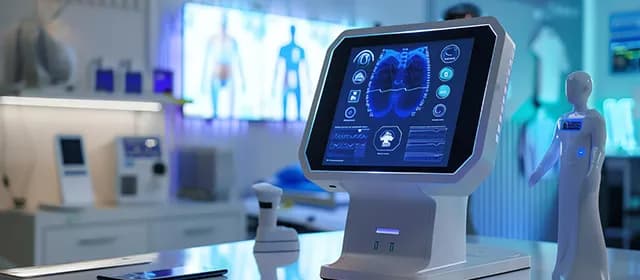By 2035, the healthcare industry will undergo a dramatic transformation shaped by technological advancements, demographic shifts, evolving patient expectations, and restructured funding models. As health systems grapple with rising costs, workforce shortages, and increasing chronic disease burdens, a critical question arises: What aspects of healthcare will attract investment, who will be responsible for delivering care, and which components will remain inherently human?
This article delves into these key themes, weaving them into a comprehensive narrative about the future of global healthcare.
From Spending to Strategy: Reimagining Investment Priorities
Global healthcare expenditures have been rising steadily over the past decades, reaching $9.8 trillion in 2021, accounting for over 10% of global GDP, according to the World Health Organization (WHO). This growth trajectory is expected to continue, with projections estimating the global healthcare management market to exceed $8.44 billion by 2031. While such figures signal strong investment, they also expose inefficiencies within traditional care models, particularly those focused on reactive treatment rather than prevention.
By 2035, there will be a significant redirection of healthcare spending toward preventive, predictive, and personalized medicine. Advances in genomics and data analytics will enable early detection of diseases and tailored interventions. Predictive algorithms will use health and behavioral data to assess individual risk profiles, allowing for interventions that delay or prevent disease onset.
The global market for digital health is expected to grow at a CAGR of over 28.57% and reach $1,394.81 billion by 2031, fueled by demand for tools that support early intervention and self-management.
Wearable health devices will play a central role in this shift. These devices will become standard in chronic disease monitoring, enabling real-time data exchange with providers and empowering patients to take a proactive role in managing their health. As a result, payers, including private insurers and public health systems, will increasingly cover the cost of these technologies when they lead to measurable improvements in outcomes and cost savings.
Funding Meets Function: How Investment Shapes Delivery Models
The shift toward predictive and preventive healthcare funding is driving a parallel evolution in care delivery. However, this transformation comes against the backdrop of a severe and widening healthcare workforce shortage. The WHO estimates a global shortfall of 11 million health workers by 2030.
- According to the Association of American Medical Colleges, the U.S. alone could face a deficit of 86,000 physicians by 2036. This gap demands new delivery models that leverage both human and technological resources.
To address these challenges, healthcare organizations are deploying multidisciplinary teams where Advanced Practice Clinicians (APCs), including nurse practitioners and physician associates, play a frontline role. These teams are increasingly supported by AI-powered tools that automate repetitive tasks, assist in diagnostics, and provide real-time clinical decision support. Radiology, pathology, and dermatology are already witnessing AI integration, with algorithms capable of matching or surpassing human-level accuracy in image recognition.
Remote monitoring and telehealth are also transforming delivery models. Telehealth usage stabilized at 13–17% of outpatient visits post-pandemic, and it’s projected to account for up to 30% of healthcare delivery by 2035. Hospital-at-home programs, enabled by IoT devices and AI triage systems, are expanding rapidly.
These delivery innovations directly support the priorities established in modern funding strategies, shifting care to lower-cost settings while enhancing outcomes.
The Economics of Efficiency: Financial Models Driving Delivery Innovation
The restructured care delivery system relies heavily on evolving reimbursement mechanisms that reward quality over quantity. Traditional fee-for-service models, where providers are paid based on the volume of services rendered, are being phased out in favor of value-based care (VBC) and capitated models. In VBC models, providers are incentivized to deliver high-quality care that leads to better outcomes at lower costs.
- According to the 2024 Health Care Payment Learning & Action Network (HCP‑LAN) survey, Medicare Advantage (MA) plans had 64.3% of payments flowing through value-based arrangements in 2023, compared with just 42% for traditional fee‑for‑service (FFS) Medicare.
Capitated models, where providers receive a fixed amount per patient regardless of services provided, are being increasingly adopted in primary care and managed care settings. This encourages preventive services, chronic disease management, and care coordination. Pharmaceutical spending is also shifting, with global expenditures projected to increase significantly by 2035. Under new reimbursement models, high-cost treatments like gene editing and regenerative medicine will receive support if they show long-term health benefits. These innovative therapies, though expensive, can improve or even save lives—making them a better investment than me-too drugs.
Digital health tools must also demonstrate not just clinical effectiveness, but cost-effectiveness. Payers are setting stricter evaluation criteria for coverage of AI-driven diagnostics, mobile health applications, and digital therapeutics.
Delivering with Empathy: The Human Touch in a Tech-Driven System
While financial models and delivery systems will continue to evolve, the human element of healthcare remains irreplaceable. Despite the expansion of AI, robotics, and automation, many patient interactions demand empathy, communication, and ethical judgment—qualities that machines cannot replicate.
- According to the HSBC/Linus Health 2035 Report, although AI is expected to assist in 32% of diagnoses and 31% of treatment decisions, only 8% of patient interactions will be fully automated.
In areas such as mental health, oncology, geriatrics, and palliative care, human clinicians will remain essential for building trust, delivering difficult news, and navigating complex emotions. Moreover, as patients interact more frequently with algorithms and remote systems, the value of in-person engagement will become more pronounced.
- According to a survey by the Pew Research Center, 60% of Americans express discomfort with healthcare providers relying on artificial intelligence in managing their personal medical care.
As AI systems become more integral to healthcare, governance frameworks will be vital to ensure transparency and accountability. Initiatives such as TRIPOD+AI and DECIDE-AI are setting ethical standards for the deployment of machine learning in medicine. However, these systems still require human oversight to interpret outputs, manage conflicts, and ensure that algorithms remain free of bias.
Toward a Human-Tech Convergence: Building the Healthcare Ecosystem of 2035
Looking ahead, healthcare will increasingly reflect a seamless partnership between human intelligence and digital innovation. The financial pivot toward preventive, tech-enabled care sets the foundation for this ecosystem. The deployment of AI, remote tools, and digital platforms enhances how care is delivered. And the essential human traits, empathy, ethics, and intuition, anchor the system in trust.
To succeed in this new era, healthcare organizations must adopt a systems-level view. Strategic investment in digital infrastructure, cybersecurity, data interoperability, and clinician upskilling will be as crucial as drug development and surgical innovations. Policymakers will need to develop adaptive regulatory frameworks that protect patients while encouraging innovation. Private and public sectors must align on data standards and reimbursement guidelines to ensure that technology delivers equitable access and meaningful outcomes.
As we look toward 2035, the answers to what will be paid for, who will deliver care, and what must remain human are not siloed considerations. They are interdependent, sequential elements of a broader system transformation. Together, they represent a unified vision: a healthcare system that is predictive, personalized, cost-efficient, and deeply human.


.webp&w=3840&q=75&dpl=dpl_56K6QShhC9wZXpDPpsYZsVak7UVB)

